- Joined
- Mar 25, 2009
- Messages
- 9,835 (1.68/day)
- Location
- 04578
| System Name | Old reliable |
|---|---|
| Processor | Intel 8700K @ 4.8 GHz |
| Motherboard | MSI Z370 Gaming Pro Carbon AC |
| Cooling | Custom Water |
| Memory | 32 GB Crucial Ballistix 3666 MHz |
| Video Card(s) | MSI RTX 3080 10GB Suprim X |
| Storage | 3x SSDs 2x HDDs |
| Display(s) | ASUS VG27AQL1A x2 2560x1440 8bit IPS |
| Case | Thermaltake Core P3 TG |
| Audio Device(s) | Samson Meteor Mic / Generic 2.1 / KRK KNS 6400 headset |
| Power Supply | Zalman EBT-1000 |
| Mouse | Mionix NAOS 7000 |
| Keyboard | Mionix |
During our visit with Silverstone, we had the opportunity to check out their new case lineup which consists of numerous new designs including an all-new Raven prototype. Keeping the unique internal layout established by the previous generations alive, the new Raven has the motherboard I/O pointed towards the top with two 180 mm air penetrator fans located at the bottom operating as intakes with a single 120 mm fan at the top as an exhaust. The design makes use of the simple concept that heat rises to great effect. Drive space is limited to a single 3.5" or 2x 2.5" drives, meaning as of now builders eyeing this new design will want to stock up on M.2 drives. While we don't have official specifications in regards to radiator support, we can say there is plenty of room to set up a water cooling loop multiple mounting points provided near the back and sides of the chassis.
Moving on the side panels are both tempered glass which gives the case a uniform look, however, thanks to that, you can forget about hiding your wire mess behind a solid back panel. Instead, the Raven Prototype will be better suited for those who meticulously route their cables keeping things exceptionally neat and tidy. As for the front panel I/O, it is located on the top left above the side panel and consists of 2x USB 3.0 ports and the usual microphone and headphone jacks. In general, the angular design of the previous Raven cases remains but has been toned down just a bit, giving this latest iteration a sleeker, stealthier appearance.
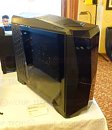
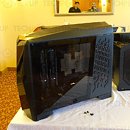
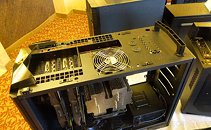
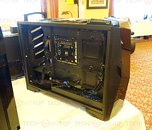
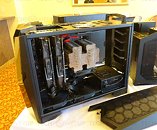
They also had other cases on display including the PS14-E which is a standard ATX mid tower case that while not extravagant delivers on features that we have come to expect in the segment including a PSU shroud, 1x 120 mm fan slot and 4x 140 mm fan slots. Drive bays are plentiful as well with 1x 5.25" external and a 3.5" or 2x 2.5" internal drive bays alongside two more 2.5" drive bays. Front panel I/O consists of 2x USB 3.0 alongside microphone and headphone jacks.
Meanwhile, the RL08 right next to the PS14-E has been designed for Micro-ATX systems and features no windows or tempered glass panels. Instead, it has a solid red panel which will immediately grab your attention. However, It should be noted that the final color will have a deeper red tone. Moving on to storage options it internally supports up to 3x 3.5" drives or 5x 2.5" drives. As for fans, the RL08 supports 1x 120 mm fan and 4x 140 mm fans by default.
The PS16 Micro-ATX chassis also makes an appearance, but it doesn't quite stand out. It features an all-black design with bumped out side panels for extra clearance along with a mesh front for improved airflow. Regarding connectivity the front panel I/O is the same as previous cases with the PS16 filling the role of a prototypical entry level chassis.
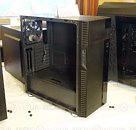
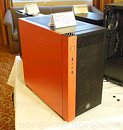
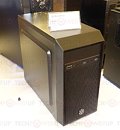
The LD03 Mini-ITX case is will likely make small form factor enthusiasts drool. It sports tempered glass and mesh side panels for looks and cooling with enough space for even a fairly large air cooler to fit without issue. Front panel I/O is again the same 2x USB 3.0 ports along with microphone and headphone jacks. Drive bays are limited to a single 3.5" bay or 2x 2.5" bays which with the rise of M.2 should be enough for most users. When it comes to cooling it has space for 2x 120 mm fans along with a single holder meant for an 80 mm fan which is about all one can expect considering the size of the case. Overall it is a sleek chassis that is a tad reminiscent of Silverstone's Fortress series just smaller and with current design trends in mind.
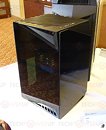
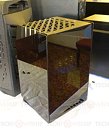
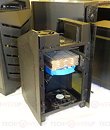
The CS381 Micro-ATX case is geared more towards storage. It offers 8x 3.5" or 2.5" hot-swap drive bays along with two more 2.5" bays for good measure. Cooling consists of 2x 120 mm fans and 2x 120 mm fan slots. In general, this case is a good option for those wanting to build their own NAS or just have a thing for mass storage in general.
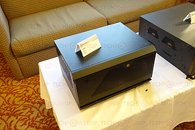
They also had a rackmount chassis on display as well which supports the SSI-EEB form factor with room for up to five 120 mm fans. Drive bays consisted of either 2x 5.25", 2x 3.5" or 4x 2.5" along with another 2.5" bay located internally.
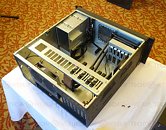
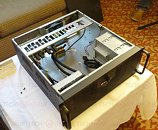
All the cases shown here are in their final forms. However, availability and pricing were not revealed during our visit.
View at TechPowerUp Main Site
Moving on the side panels are both tempered glass which gives the case a uniform look, however, thanks to that, you can forget about hiding your wire mess behind a solid back panel. Instead, the Raven Prototype will be better suited for those who meticulously route their cables keeping things exceptionally neat and tidy. As for the front panel I/O, it is located on the top left above the side panel and consists of 2x USB 3.0 ports and the usual microphone and headphone jacks. In general, the angular design of the previous Raven cases remains but has been toned down just a bit, giving this latest iteration a sleeker, stealthier appearance.





They also had other cases on display including the PS14-E which is a standard ATX mid tower case that while not extravagant delivers on features that we have come to expect in the segment including a PSU shroud, 1x 120 mm fan slot and 4x 140 mm fan slots. Drive bays are plentiful as well with 1x 5.25" external and a 3.5" or 2x 2.5" internal drive bays alongside two more 2.5" drive bays. Front panel I/O consists of 2x USB 3.0 alongside microphone and headphone jacks.
Meanwhile, the RL08 right next to the PS14-E has been designed for Micro-ATX systems and features no windows or tempered glass panels. Instead, it has a solid red panel which will immediately grab your attention. However, It should be noted that the final color will have a deeper red tone. Moving on to storage options it internally supports up to 3x 3.5" drives or 5x 2.5" drives. As for fans, the RL08 supports 1x 120 mm fan and 4x 140 mm fans by default.
The PS16 Micro-ATX chassis also makes an appearance, but it doesn't quite stand out. It features an all-black design with bumped out side panels for extra clearance along with a mesh front for improved airflow. Regarding connectivity the front panel I/O is the same as previous cases with the PS16 filling the role of a prototypical entry level chassis.



The LD03 Mini-ITX case is will likely make small form factor enthusiasts drool. It sports tempered glass and mesh side panels for looks and cooling with enough space for even a fairly large air cooler to fit without issue. Front panel I/O is again the same 2x USB 3.0 ports along with microphone and headphone jacks. Drive bays are limited to a single 3.5" bay or 2x 2.5" bays which with the rise of M.2 should be enough for most users. When it comes to cooling it has space for 2x 120 mm fans along with a single holder meant for an 80 mm fan which is about all one can expect considering the size of the case. Overall it is a sleek chassis that is a tad reminiscent of Silverstone's Fortress series just smaller and with current design trends in mind.



The CS381 Micro-ATX case is geared more towards storage. It offers 8x 3.5" or 2.5" hot-swap drive bays along with two more 2.5" bays for good measure. Cooling consists of 2x 120 mm fans and 2x 120 mm fan slots. In general, this case is a good option for those wanting to build their own NAS or just have a thing for mass storage in general.

They also had a rackmount chassis on display as well which supports the SSI-EEB form factor with room for up to five 120 mm fans. Drive bays consisted of either 2x 5.25", 2x 3.5" or 4x 2.5" along with another 2.5" bay located internally.


All the cases shown here are in their final forms. However, availability and pricing were not revealed during our visit.
View at TechPowerUp Main Site




